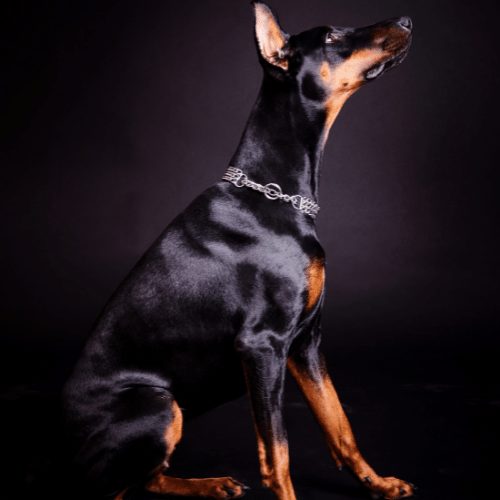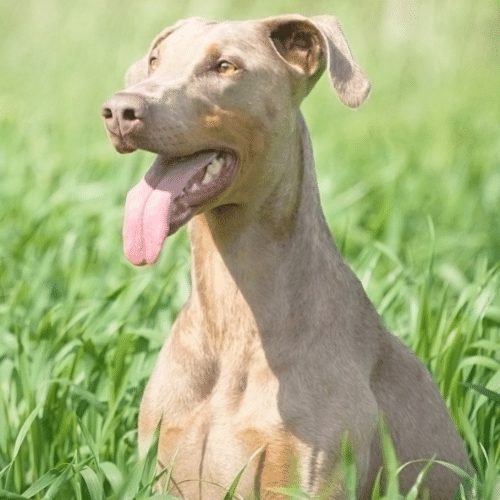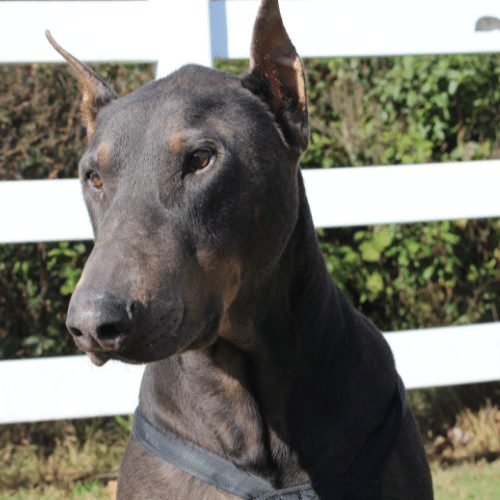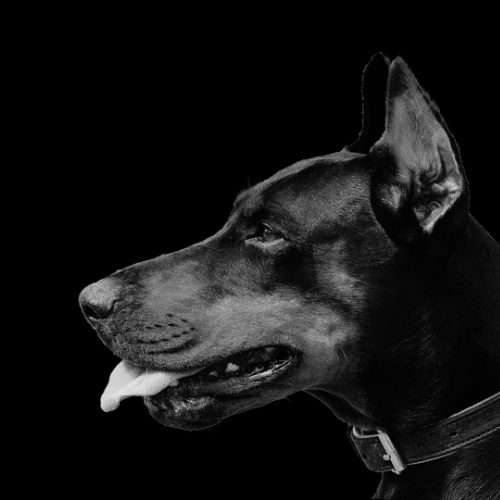Doberman Colors
July 10, 2021 2021-07-14 5:42Table of Contents

The Doberman’s Captivating Colors

#1 Black and Rust
The most common color of Dobermans of all types, black and rust is the color of the world’s most famous Dobermans, including the stars of the TV series, Magnum PI and the 1979 James Bond movie, Moonraker.
Known for their sleek, shiny coats, these muscular dogs look all the more intimidating coated in black. Black is a dominant gene, and the genotype responsible for the black and tan coloration is known as BBDD, with B representing the black gene and D the lack of dilution.
Although black and rust Dobermans are generally healthy and have the fearlessness and loyalty characteristic of the breed’s temperament, they are more prone to overheating. Their black coats absorb more of the sun’s rays than lighter colored coats, placing them at greater risk of heat exhaustion.
For the Fédération Cynologique Internationale (FCI), the black and rust Doberman is one of only two color varieties in the breed, the other being “brown with rust red.” This is at odds with the breed standards of both the American Kennel Club (AKC) and the United Kennel Club (UKC), both of which list “black, red, blue, and fawn (Isabella)” as acceptable colors.
#2 Red and Rust
The red and rust Doberman isn’t as common as the black and rust, primarily because the black gene (B) is dominant over the red (b). Two red Dobermans bred to one another will produce a litter of red puppies, but if one parent is black and doesn’t carry the red gene, the puppies will all be black.
Red Dobermans are often described as being more playful and less territorial than their black and rust cousins, though there’s no scientific evidence to support that claim.
Most red Dobermans are just as healthy and energetic as any other color and more able to withstand the hot summer sun than the black and rust version.
Although all Dobermans are susceptible to skin allergies, red Dobermans are even more prone, often developing problems with acne and skin loss during both their puppyhood and periods of stress.

Some red Dobermans may even develop the genetic skin problem, muzzle folliculitis, which is fairly common in short-coated breeds and causes lesions to form on the dog’s muzzle, lips, and chin. Fortunately, this condition is relatively easy to treat using oral antibiotics and topical antimicrobial shampoos and ointments.
If you are keen on owning a red Doberman, you can help prevent skin problems by putting your dog on a fresh food diet or a dry food specifically designed for dogs with sensitive skin and stomachs.

#3 Fawn or Isabella
Fawn or Isabella-colored Dobermans are nowhere near as common as black and rust and red and rust, and some even suggest that this is the rarest of all the Doberman colors.
With their light brown or beige coats, these Dobermans bear a greater resemblance to their Weimaraner ancestors than their black and rust cousins do. Indeed, the term Isabella is used to describe an almost lilac coat, most commonly seen in the Weimaraner.
The gene responsible for this dilution is known as Melanophilin and causes a dilution of the red gene so, “a “red” Doberman (bb) with both dilution genes present (dd) is a fawn Doberman.”
Although Fawn or Isabella is an acceptable color for the breed, according to both the AKC and the UKC, many feel these lighter-colored Dobermans are inferior to their black and red counterparts. Indeed, fawn Dobermans are “highly predisposed to color dilution alopecia” and may develop symptoms such as folliculitis and dorsal alopecia early on in life.
Fawn Dobermans have a 75% chance of developing color dilution alopecia which, in severe cases, could leave them completely hairless by the time they’re two or three years old.
This color is found in a few other breeds (apart from Dobermans and Weimaraners), such as Pitbulls (namely in the blue fawn Pittie), Cane Corsos and Border Collies.
#4 Blue
Blue is another dilute coat color that occurs naturally in the Doberman breed. Like the fawn variety, they generally have the same rust-colored paws sported by both the black and the red Doberman, but that’s where the similarities end.
Instead of the rich chestnut hue of the red Doberman or the shiny ebony of the black version, the blue Doberman sports an almost silvery colored coat that shimmers in the sun. Some blue Dobermans may be darker than others with gray or even charcoal-colored coats.
As blue is the dilute of black, the most dominant gene in the Doberman’s DNA, fawn is arguably less common as it’s a dilute of the recessive red gene.
Unfortunately, blue Dobermans are even more likely to develop color dilution alopecia, with the frequency of this condition being as high as 93% in blue dogs.

In the desire to create an unusual and eye-catching color of Doberman, some unscrupulous breeders have focused “on color rather than health,” which has genetically affected the health of many blue and fawn Dobermans.
Breeders that focus on breeding a single color rely on a very limited gene pool, which makes producing healthy offspring challenging. Not only are blue Dobermans more likely to have health issues, but they may also have aggressive or otherwise poor temperaments that make them difficult as pets and unsuitable for the show ring.
Having said that, some reputable breeders pride themselves on producing all four colors of Doberman – black, red, fawn, and blue – without compromising health or temperament.
Despite the genetic problems associated with fawn and blue Dobermans, these unusually colored dogs cost between $1,500 to $2,500 while the more common black and rust Dobermans are slightly cheaper at around $800 to $1,500.
#5 Cream or White
A cream or ivory-colored Doberman is a rare sight and is not something that either the AKC or UKC find acceptable. Sometimes referred to as partial albino, these creamy white dogs suffer from a condition known as leucism which causes a partial loss of pigmentation.
The lack of pigment in the cream-colored Doberman is responsible for the pale color of the coat and also gives them pink noses, eye rims and lips, and blue eyes.
The first white Doberman was born in 1976 and was the product of two black and rust parents. Padula’s Queen Sheba, as she was known, may not have been the first-ever white Doberman puppy, but simply the first that was allowed to live, as previous white puppies may have been euthanized because of their appearance.
Although Sheba was classified as an albino, many geneticists argue that the creamy color of her coat suggests that she wasn’t entirely lacking pigment.
During Sheba’s lifetime, many queried her lineage, suggesting that she couldn’t be a purebred Doberman but must have acquired her unusual color from some other breed. 11 years after she was born, however, Sheba’s owner was finally able to prove her purebred lineage and was allowed to register her with the AKC.
All white and cream Dobermans since Sheba are descended from her, so the pale, blue-eyed Dobermans you see today are almost certainly inbred. This trend has led to a variety of health issues for the white Doberman. Not only do they commonly suffer from problems with their eyesight and skin, but they can also be more aggressive than your average black and rust Doberman.
Experts have suggested that the white Doberman’s poor eyesight makes it uncertain of its surroundings. This problem triggers aggressive behavior and may cause fear biting and other unwanted conduct.
The gene responsible for the cream-colored coat of the white Doberman isn’t related to the other color-determining genes but rather masks or hides the intensity of the dog’s true color.
#6 Albino
As the confusion over Sheba’s genetic status suggests, albino Dobermans can be difficult to distinguish from those suffering from leucism. The easiest way to distinguish the two is by the color of their eyes. While the white or cream Doberman usually has blue eyes, an albino’s appear pink or almost colorless. Rather than the creamy color of the white Doberman, an albino will be completely white with a pinkish tinge to its coat.
As with the white Doberman, many Doberman experts and enthusiasts believe the albino has a different temperament to the red, black, fawn, and blue dogs, often exhibiting lower intelligence and increased fearfulness.
These behavioral issues could be related to the health problems associated with albinism, with some suggesting that the albino Doberman’s brain function is affected by “the lack of specific receptors,” making them highly unpredictable.
Some of the most common health problems associated with albinism include poor eyesight, photosensitivity, skin problems, and a poor-quality coat. The lack of melatonin pigment genes can also cause problems with the liver and kidney. Research also indicates that there’s a higher probability of hereditary deafness among albino dogs.

#7 Pure Black
Also known as melanistic Dobermans, these rare dogs have no rust markings at all. This unusual coloration is the result of a genetic mutation rather than a color variation and is usually caused by either the K dominant black gene or the E lotus extreme marking gene.
This color is not officially recognized, and many maintain that the solid black coat is associated with just as many health complications as the pure white variety. Others argue that melanistic animals are “healthier and longer lived.” The melanistic wolf, for instance, has better immunity to distemper and a better chance of making a successful kill as it’s harder to see.
On the other hand, black dogs are the ones most likely to get hit by motorists due to their low visibility. Make sure to have your black Doberman wear a light-up collar at all times when you walk him at night.
Putting A Spotlight on The Different Varieties of Doberman
For the majority of us, there is only one type of Doberman Pinscher and it comes in just one color – black with rust-colored markings on the legs, muzzle, chest, and throat, as well as above each eye. Doberman enthusiasts, however, are aware that there are actually three different types of Doberman that can come in a variety of colors, including blue and fawn.
The two main variants of the Doberman are the American and the European. While the American Doberman is sleeker and more streamlined, the European is a more muscular dog with a deep chest and thicker bone structure.
The American Doberman is considered more suited to the show ring and life as a companion dog, while the European is more of a working breed. With its determination and drive, the European version excels in search and rescue roles and is favored as a military and police dog.
Having said that, it was the American Doberman that assisted the US army during both the First and Second World Wars, delivering messages, finding and rescuing injured soldiers, guarding, and acting as scouts.
In addition to these two main varieties of Doberman, there’s a third, rather more controversial one – the Warlock Doberman.
Although no Doberman can be considered a small dog, Borong the Warlock was a particularly large specimen, bred by Theodosia and Henry Frampton in 1955. Borong was a huge success in the show ring and became almost legendary as a sire, with many owners bringing their females to him for breeding.
The name Warlock soon became synonymous with any large Doberman and, in the Seventies, when the desire for larger and stronger Dobermans reached its pinnacle, Dobermans crossed with larger dogs like the Great Dane and Rottweiler became known as Warlock Dobermans.
Some breeders still advertise Warlock Doberman puppies for sale, even though there’s really no difference between these dogs and the standard Doberman.
History of the Doberman
The Doberman Pinscher is a well-known yet relatively new breed whose origins may be off-putting for some, especially those with a particular hostility towards tax collectors.
Mark Twain once noted that tax collectors and taxidermists had much in common, the only difference being that “The taxidermist takes only your skin.” Being a tax collector these days isn’t anywhere near as dangerous as it was in the 1800s. Back then, taxes were collected in person rather than sent into the ether via electronic payments.
Unsurprisingly, then, tax collectors were concerned for their personal safety. Karl Friedrich Louis Dobermann wasn’t only a tax collector, he also ran the local dog pound and, it didn’t take long before he put two and two together and decided to breed a dog that was fearless enough to stand up to the most dangerous of criminals and angriest constituents.
Rather than breeding for looks, Dobermann focused on creating a dog with an “unflappable temperament,” physical strength, and a natural ability to guard. Although the exact origins of the Doberman Pinscher are unknown, it’s believed that the German Shepherd contributed to the Doberman’s stamina, intelligence, and obedience. The Weimaraner is thought to have supplied the prey drive and hunting ability that enables the Doberman to both sense danger and chase it away.
The Rottweiler is another possible predecessor to the Dobermann and could be responsible for the black and tan coat as well as the breed’s proficiency as a guard dog.
According to an old acquaintance of Dobermann, Otto Göller, a crossbreed called Schnuppe gave birth to the first litters of Dobermans. She had been mated to what he described as a “butcher’s dog” which many believe was “the ancestor of the present-day Rottweiler crossbred with a sheepdog.”
Not all Dobermann’s early breeding efforts were a success and several of his dogs exhibited such a high prey drive that they ended up being shot by local hunters after a rather overenthusiastic pursuit of game.
The Doberman we know today bears significant resemblance to Dobermann’s early attempts but is more refined thanks to the efforts of Otto Göller and Philip Gruening who introduced Greyhound and Manchester Terrier to the breed. This gave the breed some of the sleekness and speed we associate with it today
What’s The Most Popular Doberman Color?
Not only is black and rust the most common color of Doberman, but it’s also the most popular. According to a survey conducted by Doberman’s Den, 62% of the voters chose black and tan as their favorite color, with red and rust Dobermans coming in second with 24%. Blue Dobermans proved slightly more popular than fawn with 8% of the votes, compared to fawn’s 6%.
Which Is The Rarest Color For A Doberman?
There are widely varying opinions about which color of Doberman is the rarest. While some argue that the cream or white Doberman is the least common, others claim the pure black Doberman, without rust markings, is the rarest of them all. Still others, however, maintain that the blue Doberman is the least common, making up just 8-9% of the breed.
Are Dobermans Dangerous?
Although a well-trained Doberman can make a fun and loyal family pet, this breed is considered one of the most dangerous in the world. Breed-Specific Legislation has also seen the Doberman banned in several states, including Arkansas, Iowa, Kansas, Missouri, and Washington.
Author box

Author: Nicky Hoseck
Nicky lives on a small-holding on South Africa’s Wild Coast with a selection of animals, a husband, and five dogs. She spends all her waking hours with her Australian Cattle Dog, Koala, either walking, horse-riding, running, or just hanging out.
Originally from the UK, Nicky been living with dogs for over 40 years and is a passionate dog-owner.
With a Masters Degree from the University of London under her belt, Nicky has had a diverse career, training and riding horses, running safari lodges, and hosting volunteers. She’s now a full-time writer.

